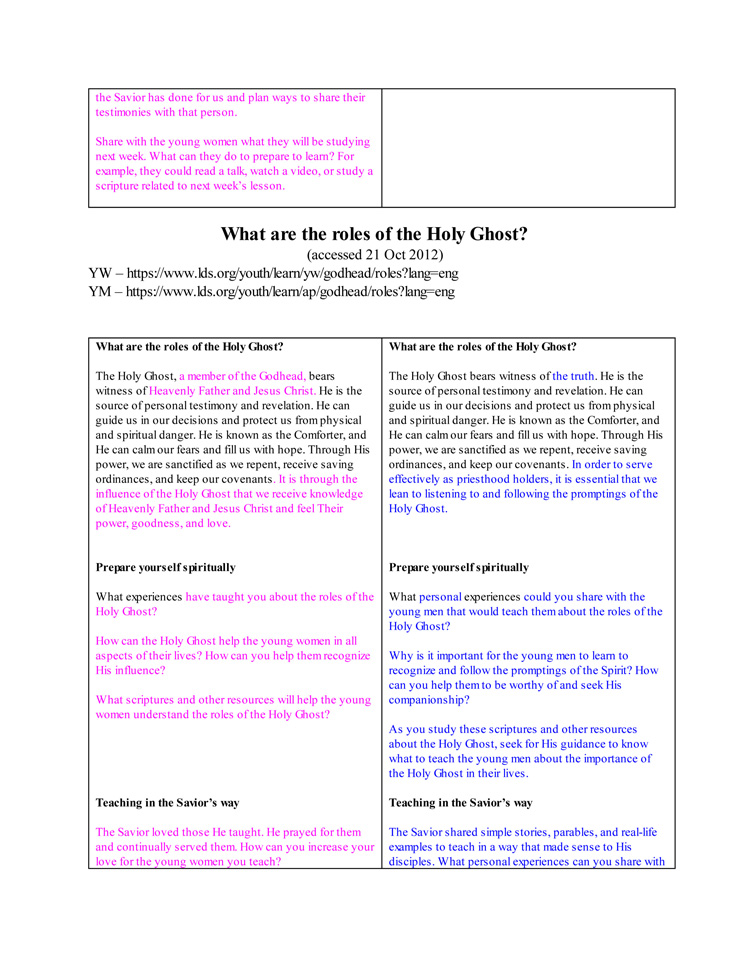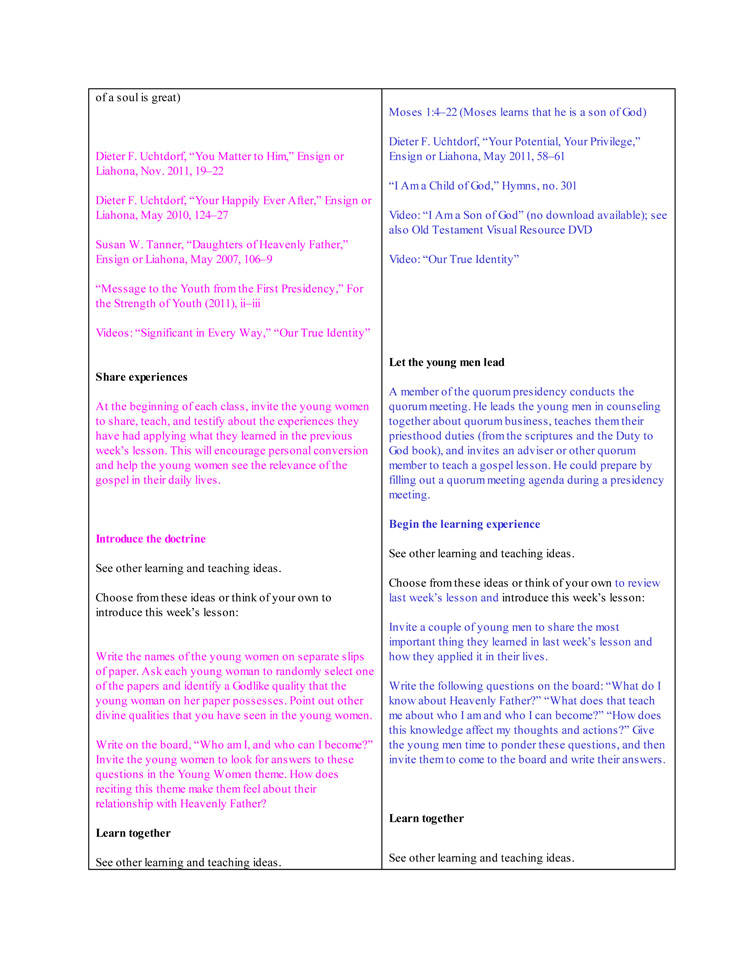The church has finally updated the curriculum for the YW/YM’s programs. At long last. We published two comparisons of the YW/YM lessons in 2012–both written diligently and conscientiously by Laura C. You can read them here and here. The following is a side-by-side comparison of the January 2013 themes that teachers will begin using today (January 6, 2013).
[The charts below are images; therefore, links are inoperable. For your information, general information about the new curriculum can be found here; the January YW curriculum can be found here; the YM manual, here.]



























It’s interesting to see how differently the same material is tailored to the young women vs. the young men. It appears there is a great deal more encouragement to the YM to practice leadership skills and to the YW to be introspective or share with other members of the group. Clearly there is a reason for drawing up two entirely separate guidelines for teaching what is, relatively-speaking, the same curriculum.
AAAAAAAAARRRRGGGHHHHH!!!!! They explicitly tell the teachers to read from Holland’s Talk “The Only True God And Jesus Christ Whom Thou Hast Sent” FOR THE EXPRESS PURPOSE OF LEARNING WHAT OTHER CHRISTIANS “BELIEVE”. Holland’s approach in that talk is disturbingly unfair and he knows enough to know better. I THOUGHT WE HAD MOVED ON FROM TALKING ABOUT WHAT “OTHER CHRISTIANS” BELIEVE IN OUR MEETINGS. I’m sorry to yell, but that just makes me furious. Apart from the conception of The Father as embodied or the Son as eternally with a body, Christians believe that the Triune God is One God composed of three persons. While is EXACTLY what the teachers in the lessons here are told to say to their class about the “Godhead”! Why do Mormons continue to push this false difference between themselves and traditional Christians?
So many thoughts. I do think it is an improvement over old manuals, but find it dissappointing to see that while YM are expected to prayerfully seek inspiration, YW leaders are told to find talks to reference.
The lesson that affected me most was “Who am I and what can I become”- it’s been hard for me to put into words, especially since I’m only just now fully aware of it, that as a YW I felt like we talked about potential all the time but not about the amazing 14-year-olds we were. The YM manual has them name talents and skills they already have; the YW manual uses the object lesson of a seed and talks of potential. *sigh*. But that’s a much bigger issue than just the manual.
Most of the problems are much bigger issues than just the manual, IMO . . .
Jenn – the whole idea of potential vs present is a problem throughout the lessons. It makes the YW lessons much less concrete and much more abstract. It’s hard to tell if this is because women had a role in editing the YW lessons (and have been brought up to think of YW as “potentials” – this is how we speak to and about young women) or if it’s because editors think YW relate more to abstracts than realities. Or maybe they think the YM need concrete examples more often?
It’s clearest when there are whole paragraphs that are nearly identical and then just one question or phrase (or even one word) is changed between the two lessons. Obviously, somebody wanted to introduce a difference between the YM and YW lessons at some point, otherwise they would be much different than they are. But it’s sometimes hard to tell whether the differences are due to editorial tone preferences or deliberate attempts to give separate messages to each gender.
I suspect that there are instances of both and that sometimes the changes are deliberate (with the non-deliberate changes reflecting the way we’ve traditionally spoken to/about women and girls, so some language “just sounds right/better this way.”)
There were a few sections that really popped out at me. First, where the YM are told “We are made in God’s image.” But the YW are told, “Men are made in God’s image.” And second, the part in the Holy Ghost section where extra time is spent comparing The Lord’s values for women to “the world’s” values for women. Again, using us vs. them tactics to keep the YW from looking outside what they’re being taught. It’s rewarding them for being afraid of outside ideas, IMO. Encouraging phobias. And I feel similarly about how both manuals paint other churches in comparison to Mormonism.
Here’s a difference that stood out to me, from the lesson Who am I and what can I become?
The YW get: We are beloved spirt daughters of heavenly parents, and as such, we have divine nature and destiny.
The YM get: We are sons of Heavenly Father, created in His image, with the potential to become like Him.
Odd that they leave out the reference to a Heavenly Mother for the boys. But even in mentioning her to the YW, knowing so little about her they can’t say anything about the potential to become like Her or that the YW are created in her image. I guess its good that there is more talk of heavenly parents period, but that difference is a big one to me.
I read these when Laura put them out originally. Some interesting differences. What’s missing is the comparison to the third part of the youth curriculum, which is the Sunday School part which follows the same themes as mutual but is presumably designed for the combined audience. Has anyone looked at this yet or is it still a work in progress? :)